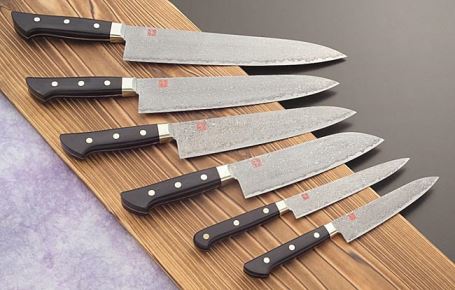HOW TO CHOOSE THE RIGHT COOKING KNIFE

Very few people realise that one of the main secrets to good cooking is a wise choice of knives. Your knives should be comfortable to hold, not too heavy and with the right shape of handle, and they must be effective too. In this article we give you a quick guide to kitchen knives.
One of the most important factors that affect the quality of the food you cook in your kitchen is – believe it or not – your choice of knives. Many amateur cooks underestimate the importance of the knife in the preparation of a dish. Choosing the right knife can make all the difference because:
- It gives your food the correct texture
- You accomplish tasks more efficiently
- The right knife is safer
Here are the six main types of knives that you need to be aware of.
Paring knife
This is a short knife with a blade of around 2-4 inches. Choose one with a handle that fits snugly in your hand. It is ideal for small, delicate tasks that come up during the average cooking day, like peeling garlic, trimming mushrooms and slicing small fruits like strawberries. These knives come in a range of sizes, so make sure that you pick the one that fits well in your hand and is not too heavy.
Utility knife
This is slightly bigger than a paring knife, with a blade around 6-8 inches long. This is ideal for a wide variety of jobs during food preparation, like chopping vegetables, slicing fish and cutting cheese. If you can get just one knife for your cabinet, make sure you get this one because you can do just about any job with passable quality with it.
Chef knife
This is like the utility knife in the sense that it is multi-purpose, but it is a larger version, with an 8-14 inch blade. Considered the quintessential kitchen knife for general tasks, you can make classic cuts and dice and fine chop fruits, vegetables, meat and fish. It takes a little while to get used to its size and weight, but once you do, it’s a lovely knife to work with.
Serrated knife
You need one knife with a serrated blade in your kitchen for those soft foods, like bread and tomatoes. With this knife you let the weight of the blade and the serrations do the cutting, just drawing your hand back and forth, holding the knife like an artist would a brush. Delicate desserts and flaky pastries are just around the corner once you learn how to use this.
Santoku
This is the multi-purpose knife the Japanese use for slicing, dicing and mincing vegetables. Visit any Asian restaurant and you will find this knife figure prominently in the chef’s toolkit. If you have small hands or if you find the chef knife a bit too heavy, the Santoku can be a great replacement.
Boning knife
A boning knife is used exclusively for carving meat off of bones and for trimming fat. It has a very sharp, thin blade which is 5-7 inches long. Some cooks prefer a flexible blade whereas others like to work with a rigid one. Choose whatever works for you, and remember that a flexible bladed knife requires you to be more dextrous to avoid injuring yourself.





